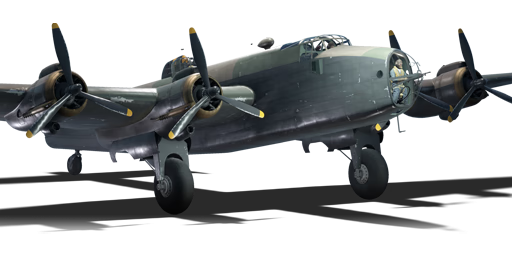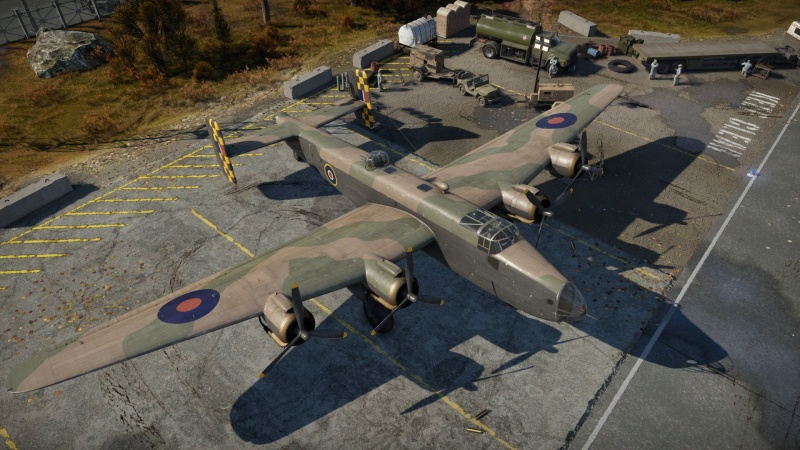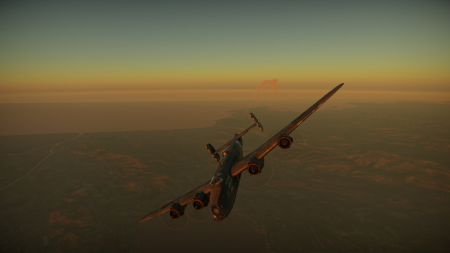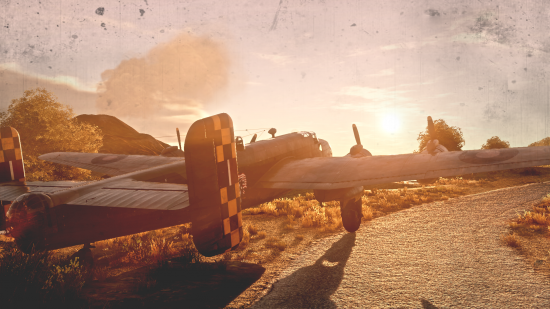Difference between revisions of "Halifax B Mk IIIa"
keenanhasya (talk | contribs) (→Media) |
(→Media) |
||
| Line 195: | Line 195: | ||
The B Mk. III was the most produced variant of the Halifax, beginning service in November of 1943. The main improvement included replacing the underperfomring Rolls-Royce Merlin X engine with the more powerful Bristol Hercules XVI. This allowed the Halifax to perform better and increased its ceiling, a critically needed change that allowed the Halifax to fly at altitudes needed to avoid enemy fighters, whose attacks were becoming increasingly effective by that point of the war. Other changes included the adoption of de Havilland Hydromatic propellers and rounded wing tips. A total 2,091 were built. | The B Mk. III was the most produced variant of the Halifax, beginning service in November of 1943. The main improvement included replacing the underperfomring Rolls-Royce Merlin X engine with the more powerful Bristol Hercules XVI. This allowed the Halifax to perform better and increased its ceiling, a critically needed change that allowed the Halifax to fly at altitudes needed to avoid enemy fighters, whose attacks were becoming increasingly effective by that point of the war. Other changes included the adoption of de Havilland Hydromatic propellers and rounded wing tips. A total 2,091 were built. | ||
| − | + | == Media == | |
| − | ''Excellent additions to the article would be video guides, screenshots from the game, and photos.'' | + | <!-- ''Excellent additions to the article would be video guides, screenshots from the game, and photos.'' --> |
| + | {{Youtube-gallery|VTLOUPW67to|'''Ultra Cheeky Sneaky Tea - Halifax B Mk III a''' - ''Napalmratte''}} | ||
== See also == | == See also == | ||
Revision as of 09:14, 11 February 2021
Contents
Description
The Halifax B Mk IIIa is a rank III British bomber with a battle rating of 4.0 (AB/RB) and 4.3 (SB). It was introduced in Update 1.59 "Flaming Arrows".
The Halifax is an interesting member of the British bomber line. It is the first true British heavy bomber, a big change from its predecessors, which are all either flying boats, medium, or light bombers. With the transition to heavy bombers, comes a change in tactics. The Halifax will outclass almost every rank 2 and 3 bombers in terms of payload. It will also generally beat every same battle-rated bomber in the payload department as well. However, being a heavy bomber has its drawbacks. Compared to nearly all previous British bombers, this one is slower and has a noticeably slow climb rate. While the payload upgrade is nice, the Halifax is not very durable. Worse, the Halifax lacks effective defensive weapons, a flaw of nearly all British bombers. The main priority, as a result, should be targeting bases and avoiding opposing pilots as much as possible. Use high altitude and less direct travel routes to get to your targets. If you are engaged, your defensive guns can save you, but they are not very reliable. In addition, this bomber does not have any ventral turrets, leaving a massive defensive gap directly under the aircraft. You also only have one singular machine gun able to cover the fore-lower approach to your aircraft and little in the way of armour plating for the pilot other than a steel bulkhead that won't protect against cannon shells or rifle calibre bullets well. However, if you can keep safe and deliver your payload, you will find this to be a very effective bomber.
General info
Flight performance
| Characteristics | Max Speed (km/h at 4,115 m) |
Max altitude (metres) |
Turn time (seconds) |
Rate of climb (metres/second) |
Take-off run (metres) | |||
|---|---|---|---|---|---|---|---|---|
| AB | RB | AB | RB | AB | RB | |||
| Stock | 436 | 420 | 7620 | 35.0 | 35.8 | 3.8 | 3.8 | 750 |
| Upgraded | 478 | 454 | 33.2 | 34.0 | 9.9 | 6.5 | ||
Details
| Features | ||||
|---|---|---|---|---|
| Combat flaps | Take-off flaps | Landing flaps | Air brakes | Arrestor gear |
| ✓ | ✓ | ✓ | X | X |
| Limits | ||||||
|---|---|---|---|---|---|---|
| Wings (km/h) | Gear (km/h) | Flaps (km/h) | Max Static G | |||
| Combat | Take-off | Landing | + | - | ||
| 0 | 260 | 520 | 520 | 260 | ~4 | ~3 |
| Optimal velocities (km/h) | |||
|---|---|---|---|
| Ailerons | Rudder | Elevators | Radiator |
| < 350 | < 370 | < 350 | > 280 |
| Compressor (RB/SB) | ||
|---|---|---|
| Setting 1 | ||
| Optimal altitude | 100% Engine power | WEP Engine power |
| 1,447 m | 1,400 hp | 1,596 hp |
| Setting 2 | ||
| Optimal altitude | 100% Engine power | WEP Engine power |
| 4,115 m | 1,300 hp | 1,482 hp |
Survivability and armour
- 6.35 mm steel in front and floor of the cockpit
- 8 mm steel behind the pilot and in rear fuselage bulkhead
Modifications and economy
Armaments
Suspended armament
The Halifax B Mk IIIa can be outfitted with the following ordnance:
- 15 x 250 lb G.P. Mk.IV bombs (3,750 lb total)
- 15 x 500 lb G.P. Mk.IV bombs (7,500 lb total)
- 9 x 1,000 lb M.C. 1,000 lb Mk.I bombs + 6 x 500 lb G.P. Mk.IV bombs (12,000 lb total)
Defensive armament
The Halifax B Mk IIIa is defended by:
- 1 x 7.7 mm Vickers K machine gun, nose turret (1,000 rpg)
- 4 x 7.7 mm Browning machine guns, dorsal turret (600 rpg = 2,400 total)
- 4 x 7.7 mm Browning machine guns, tail turret (1,700 rpg = 6,800 total)
Usage in battles
The Halifax Mark IIIa is the first true "heavy" bomber that an allied player will unlock. It has engines that do well at higher altitudes- above the height of 4000 metres- and it has a large payload of nearly 12000 pounds of bombs, going by weight. This is sufficient so that one Halifax can, on their own, annihilate all three minibases and take a small chunk out of the enemy airfield, and otherwise, it can take a sizeable chunk out of the airfield- around three-quarters of the base's total HP. Two Halifaxes can annihilate all the bases and the airfield together in the 3.7-4.7 BR bracket. Three Halifaxes can destroy everything in a 5.0 uptier. Four halifaxes, should they survive the trip to the enemy bases, can destroy everything they see on the map and result in a fast game-over. It dwarfs the payloads of contemporary 4.0 bombers, such as the Pe-2-83, B-25J-1, and the Yer-2 (M-105) with its overwhelmingly large bombload.
However, the Halifax is not all explosions, sunshine and rainbows. The aircraft requires you to play very defensively and requires you to be a crack shot with the turrets and able to know where enemies are going and be lucky enough to avoid their ire. The Halifax B Mk IIIa is a British bomber, and in-game, has a notorious reputation for carrying a lot of bombs but being unable to avoid fighter aircraft (doesn't climb fast enough nor perform well enough at high altitude) or defend itself (four/eight 7.7mm machine guns is barely adequate at 3.3, let alone 4.0). While it does have a good bombload, pilots will find that it has problems in actually getting to the target.
One technique that some british pilots use to some degree of success are low-altitude dambusters-style raids flying at treetop level, just above terrain. This allows you to avoid axis fighters (which generally climb high), but if executed wrong, will simply leave you at the mercy of Bf-109s, Fw-190s and low-flying japanese aircraft which will enjoy the opportunity for a free kill. You need to be watching the skies and make course corrections to avoid enemy aircraft, since you do not have the weapons nor performance to take them out or outrun them. You need to pre-empt where enemy aircraft will be and make adjustments as such. You are also harder to see above water, above forests and above large urban areas (e.g. the cities on Ruhr). use this to your advantage.
Manual Engine Control
| MEC elements | ||||||
|---|---|---|---|---|---|---|
| Mixer | Pitch | Radiator | Supercharger | Turbocharger | ||
| Oil | Water | Type | ||||
| Not controllable | Controllable Not auto controlled |
Not controllable Not auto controlled |
Controllable Not auto controlled |
Combined | Controllable 2 gears |
Not controllable |
Vent the radiator and set prop pitch to 100% immediately after spawning in. Set supercharger gears to gear 2.
For some extra speed in level flight set prop pitch to 85%.
Pros and cons
Pros:
- Versatile - It is capable of flying low-altitude runs for minibases, or high-altitude bomb runs.
- Can carry an overwhelming 12,000 lb of bombs, giving it the heaviest payload at rank II-III, and outclasses many rank IV bombers
- (Realistic Battles) Full payload lets it take out all three bases in one pass with four 1,000 lb bombs to spare (first base : 6 x 500 lb + 1 x 1,000 lb / second base : 2 x 1,000 lb / third base : 2 x 1,000 lb / airfield : 4 x 1,000 lb
- Full payload can also take out 3/4 of an Airfield's HP in the BR 3.7-4.7 range
- Fast and fairly manoeuvrable for a heavy bomber, with flaps that do not rip easily
- Performance is almost unaffected by payload options due to internal payload carriage that doesn't create drag
- Fantastic climb rate with WEP; can easily reach 6,000 m with full payload just by side climbing (which is heavily advised to minimize interception)
- Can fly with two engines if needed - or even one, if trying to land
- Defensive armament is decent for a British bomber. You can put eight guns rearward to defend against enemy targets
- Tail gunner has a lot of ammunition (4 x 7.7 mm machine guns with 1,700 rounds per gun). In addition, he can fire almost directly down, directly under the turret, so unless an enemy goes directly under your airframe, you should have time to react and fire a few bursts
- Economical plane to fly as an easy Silver Lion
 and Research Points
and Research Points  grinder
grinder - The aircraft, if in the hands of a capable pilot, can continue to fly with horrific damage to control surfaces and engines
Cons:
- Large target
- Priority target (in Arcade battles) to be eliminated
- Stock payload is useless for base bombing, but plane isn't manuverable enough to effectively attack smaller ground targets
- Nose is defended by a single 7.7 mm gun and the belly has no machine gun coverage, leaving them very vulnerable for enemy attacks
- 7.7 mm turrets are overall not very effective
- Only one pilot, no copilot like other bombers. In addition, the pilot is not armoured, and is vulnerable to a head-on, since the only frontal defence is a single 7.7mm gun
- WEP causes overheating unless manual engine control is used to force radiators open
- Fragile structure compared to most competing bombers and previous British bombers
- Severe lack of armour for crew leaves them vulnerable
History
The Handley Page Halifax was an archetypal British heavy bomber, making up nearly half of all that were produced. At the point of its maximum production, its operations enveloped 41 separate factories, 600 subcontractors and 51,000 employees, with one Halifax completed every hour. The peak of its usage saw 76 Halifax-equipped Bomber Command Squadrons. As with the rest of its kind, the Halifax was known for its huge, lumbering profile and punishing bomb load. During its service with Britain, it flew 82,773 operations and dropped 224,207 tons of bombs. A grand total of 6,178 Halifaxes of all variants were built, with 1,833 planes lost.
During the mid-1930s, the British Air Ministry released Specification P.13/36, which detailed its need for a twin-engined medium/heavy bomber, suitable for "world-wide use". Multiple aircraft manufacturers submitted designs to meet its requirements, among them Handley Page, which submitted the HP56. By February 1937, the list of aircraft designed to meet specification was narrowed down to two candidates, Handley Page's HP56, and rival manufacturer Avro's Avro 679, with the possibility that both designs were to be selected. Ultimately, the 679 alone was selected for production and dubbed the "Manchester", as the Air Ministry had other plans for the HP56. After both American and Soviet engineers saw success in experimentation with four-engined bombers, the Air Ministry became interested in the concept. Accordingly, in 1936, it released Specification B.12/36, which detailed a four-engined heavy bomber with a range of 2,000 miles (~3,200km), capable of carrying 14,000lbs (6,350kg) of ordinance. In 1937, as it prepared to select the 679 to meet P.13/36, the Air Ministry asked Handley Page to redesign the HP56 in order to meet B.12/36. By the end of the year, the initial design, designated the HP57, was complete. The RAF was so impressed with the design that in January of 1938, it ordered 100 of the aircraft into production. Construction of the prototype began in March 1938. It made its first flight on October 25, 1939, and after subsequent successful tests, was given the name "Halifax". It officially entered service in November of 1940, and flew its first combat mission, a bombing raid of the Le Havre docks, on March 10-11, 1941, but its existence was not confirmed by the RAF until it took part in a daylight bombing raid in July. Besides bombing raids, its duties included pathfinding, supply transport, paratroop transport, and, under Coastal Command, anti submarine, reconnaissance, and meteorological operations. Towards the end of the war in Europe, a few Halifaxes were modified for Allied use in the Pacific, but were ultimately too late to have any real effect on the outcome of that theatre. After the war, it was retired from British military service, and a majority of Halifaxes were scrapped. However, many found civilian use both at home and abroad. In addition, they remained in military service for the French, Egyptian, and Pakistani Air Forces. It remained in Pakistani service until 1961.
The B Mk. III was the most produced variant of the Halifax, beginning service in November of 1943. The main improvement included replacing the underperfomring Rolls-Royce Merlin X engine with the more powerful Bristol Hercules XVI. This allowed the Halifax to perform better and increased its ceiling, a critically needed change that allowed the Halifax to fly at altitudes needed to avoid enemy fighters, whose attacks were becoming increasingly effective by that point of the war. Other changes included the adoption of de Havilland Hydromatic propellers and rounded wing tips. A total 2,091 were built.
Media
See also
Links to the articles on the War Thunder Wiki that you think will be useful for the reader, for example:
- reference to the series of the aircraft;
- links to approximate analogues of other nations and research trees.
External links
| Handley Page Limited | |
|---|---|
| Bombers | Hampden Mk I · Hampden TB Mk I · Halifax B Mk IIIa |
| Export | ▂Hampden TB Mk I |
| Britain bombers | |
|---|---|
| Torpedo | Swordfish Mk I · Swordfish Mk II · ▄Avenger Mk II |
| Dive | V-156-B1 |
| Hydroplanes | ▄Catalina Mk IIIa · Sunderland Mk IIIa · Sunderland Mk V |
| Light | Blenheim Mk IV · Beaufort Mk VIII · ▄Hudson Mk V · Brigand B 1 |
| Based on A20 | ▄Havoc Mk I · ▄Boston Mk I · ▄DB-7 |
| Hampden | Hampden Mk I · Hampden TB Mk I |
| Wellington | Wellington Mk Ic · Wellington Mk Ic/L · Wellington Mk III · Wellington Mk X |
| Halifax | Halifax B Mk IIIa |
| Stirling | Stirling B Mk I · Stirling B Mk III |
| Lancaster | Lancaster B Mk I · Lancaster B Mk III |
| Lincoln | Lincoln B Mk II |
| Shackleton | Shackleton MR.Mk.2 |







